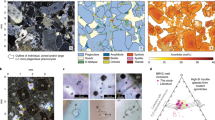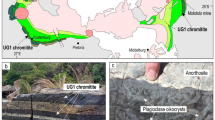Abstract
THIS memoir is probably the most instructive contribution to modern petrology since Brögger published his description of the Oslo area (1931)1. It describes the north-eastern (British) part of the Birunga lava-field—a region of Tertiary and Recent vulcanism which produced ‘alkali’ lavas of basic to intermediate composition. The field extends along, and partly across, the Western Rift depression for some fifty miles north and north-east of Lake Kivu.
This is a preview of subscription content, access via your institution
Access options
Subscribe to this journal
Receive 51 print issues and online access
$199.00 per year
only $3.90 per issue
Buy this article
- Purchase on Springer Link
- Instant access to full article PDF
Prices may be subject to local taxes which are calculated during checkout
Similar content being viewed by others
References
Brögger, W. C., "Der Grosse Hurumvulkan. Die Eruptivgesteine des Oslogebietes", (5) Videns. Skrift. (1), Math.-Nat. Kl., No. 6 (1931).
Finckh, L., "Die Jungvulkanischen Gesteine des Kiwusee-Gebietes". Wiss. Ergebn. Deutsch. Zentral-Africa-Exped., 1907–1908, 1 (1) (1912).
Rights and permissions
About this article
Cite this article
BRAMMALL, A. Transfusion in Petrogenesis*. Nature 143, 649–650 (1939). https://doi.org/10.1038/143649a0
Issue Date:
DOI: https://doi.org/10.1038/143649a0
Comments
By submitting a comment you agree to abide by our Terms and Community Guidelines. If you find something abusive or that does not comply with our terms or guidelines please flag it as inappropriate.



